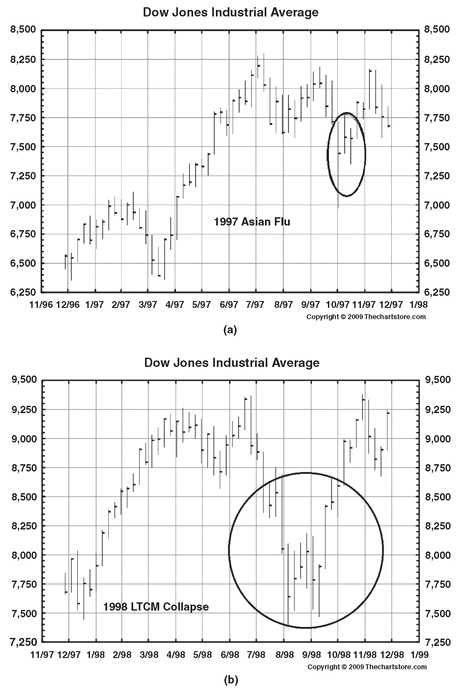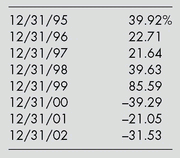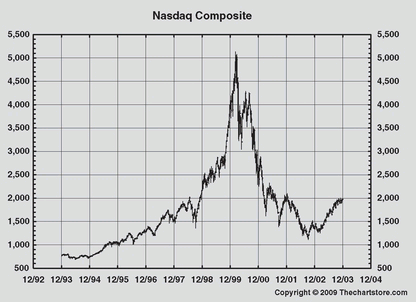Bailout Nation (13 page)
Authors: Barry Ritholtz


Too Smart for Their Own Good
Long-Term Capital Management (LTCM) used sophisticated trading techniques, but its business model was fairly simple. Using proprietary software, the traders identified price spreads that were wrong according to the quants' models. However, these price discrepancies were very small on a percentage basis. In order to make money doing this, they had to use leverage to make the price differentials add up to anything significant. This meant LTCM borrowed lots and lots of money against their investors' cash, and then put that to work following the computer's algorithms.
Since the bond market is so deeply tradedâmillions of traders trade trillions of dollars' worth every dayâeven with the leverage, their choices were limited. So they took the road less traveled, or in LTCM's case, the bond less traded. Ordinary Treasuries could not satisfy their itch; instead, their proprietary models found ever rarer and more exotic fixed-income instruments. These were not well followed or understood, nor were they deeply traded. The quants at LTCM thought this gave them an advantage, as they understood these instruments better than many, indeed most. Off they went in search of lesser-known markets. Leaving the main river, they soon found themselves in unknown eddies, trading exotic fixed-income marketsâlike those soon-to-be defaulting Russian bonds.
This worked well, so long as prices were behaving as the models forecast. Wide spreads were supposed to tighten, and rising prices were supposed to keep rising. Once prices stopped behaving as the models forecast, however, trouble soon followed.
The leverage that so enhanced returns on the way up began to slaughter capital on the way down. For those trading their capital without leverage, a 10 percent loss is a relatively minor inconvenience. If you are leveraged 10 to 1, however, a 10 percent loss wipes you out totally.
And if you're leveraged 100 to 1 like LTCM was, well, then you're just begging for trouble.
To someone whose only tool is a hammer, pretty soon everything begins to look like a nail. Greenspan cut rates 25 basis points on September 29, 1998. Two weeks later on October 15âbetween meetings!âhe cut another 25. A scheduled Fed meeting on November 17 brought yet another quarter-point cut. In seven weeks, “Easy Al” lopped off 75 basis points from the federal funds rate.
The statement after the November cut was unusually telling: “Although conditions in financial markets have settled down materially since mid-October, unusual strains remain.”
6
6
Thus, the Greenspan put was born.
About the same time Easy Al was cutting rates that September, William J. McDonough, the president of the New York Federal Reserve Bank, was having a little get-together one Tuesday evening at the Fed's fortresslike building on Maiden Lane. He called for a meeting of the
patresfamilias
âthe heads of the 16 largest banks, along with the New York Stock Exchange chairman. The discussion was over what to do about the imminent collapse of Long-Term Capital Management.
patresfamilias
âthe heads of the 16 largest banks, along with the New York Stock Exchange chairman. The discussion was over what to do about the imminent collapse of Long-Term Capital Management.
Roger Lowenstein's narrative,
When Genius Failed
(Random House, 2000), is a fascinating read for anyone interested in the grisly details of LTCM. For our purposes, we need only note two facts:
When Genius Failed
(Random House, 2000), is a fascinating read for anyone interested in the grisly details of LTCM. For our purposes, we need only note two facts:
1. The Fed was cutting rates.
2. The Fed was using its authority and prestige to help work out the demise of what was a private partnership.
The central bankers jawboned the 14 largest banksâwith the notable exception of future bailoutee Bear Stearnsâinto kicking in $3.65 billion to buy out the assets of LTCM. These included leveraged assets of over $100 billion and derivatives with a notional value of over $1 trillion.
The belief that LTCM had to be bailed out was widely held. It was 1987 redux, and the media accolades poured in. In the aftermath of the LTCM rescue,
Time
put Alan Greenspan, Robert Rubin, and Larry Summers on the cover as “The committee to save the world.”
7
Time
put Alan Greenspan, Robert Rubin, and Larry Summers on the cover as “The committee to save the world.”
7
The chaos surrounding a liquidation of LTCM would cause the markets, in Chairman Greenspan's words, to “seize up.”
But this raises uncomfortable regulatory questions. If this huge leveraged fund presented such systemic risk, then why weren't there regulations limiting the size and the leverage that hedge funds could use?
Note the ideological quandary this created for the chairman who believed markets could “self-regulate.” Either these funds are too dangerous to be allowed to exist without strict oversight and controls, or this was not a case of systemic risk. There can be no middle ground; he had to either change the rules or change his belief system.
Of course, that's not how Greenspan saw it. The failure of LTCM would have had a very negative impact on psychology. Woe to the Fed chair who allows traders to become morose! That was how Mr.
Atlas Shrugged
rationalized the intervention. (Thank goodness Ayn Rand was already dead.)
Atlas Shrugged
rationalized the intervention. (Thank goodness Ayn Rand was already dead.)
Whether that would have turned out to be true is a matter of much dispute. The evidence leads me to surmise that not only would LTCM's demise
not
have caused the system to collapse, it would have done a world of good. Indeed, the best possible outcome would have been for LTCM to go belly-up and take a big bite out of the investment banks dumb enough to lend all that money to LTCM.
not
have caused the system to collapse, it would have done a world of good. Indeed, the best possible outcome would have been for LTCM to go belly-up and take a big bite out of the investment banks dumb enough to lend all that money to LTCM.
Consider what was at stake: First, LTCM's portfolio had $100 billion in leveraged paper. But it was the leverage, not the paper, that was the issue. Everything LTCM owned wasn't Russian debt heading to zero; some of it had real value. The problem wasn't the quality of the assets; it was using $1 to buy $100 worth of paper. It doesn't take much spread widening to lose a substantial amount of capital when you are running that much leverage. As we will see in Part IV, that would have been a ripping good lesson for the investment banks to have learned.
What the banks actually learned was that the Fed (and by extension, Uncle Sam) would be there to back them up when they ran into trouble. This is precisely what moral hazard argues against: Encouraging risk-taking to become separated from its consequences.
The other issue was the trillion dollars in derivatives. How did an unregulated, three-year-old, heavily leveraged partnership manage to have so much in “insurance” entrusted to it by counterparties? The only answer I can deduce is that the number of idiots on the planet is greater by several orders of magnitude than previously believed. If you have been paying any attention, that many of them work in finance should come as no surprise.
This was yet another lesson sorely not learned.
What would have happened had this notional amount of derivative paper become worthless? Short answer: not a whole lot.
The loss would have been the premiums paid to LTCM, not the trillion-dollar notional value. If your car insurance company disappeared tomorrow, you wouldn't lose the value of your vehicleâonly the premium payments you made. This is why it's advisable to do business with firms such as the Government Employees Insurance Company (GEICO) or Allstate, and not Billy Bob's Bait Shop & Auto Insurance Co.
The penalty for getting into bed with a counterparty that was young, untested, highly leveraged, and reckless should have been expensive. Instead, it was a minor inconvenience. It was yet another lesson not learned from LTCM, and contributed mightily to moral hazard. Future repercussions would be severe.
Had LTCM been allowed to fail naturally, perhaps a lesson might have been learned: Risk and reward are sides of the same coin. Alas, it was a missed opportunity for the traders and risk managers at major banks and brokers to learn this simple truism. The parallels between what doomed LTCM in 1998 and forced Wall Street to run to Washington for a handout in 2008 are all there, and the significance of these missed opportunities is now readily apparent.
In sum, Long-Term Capital Management was the dress rehearsal for the great credit crisis of 2008âand a missed opportunity to prevent the ongoing tragedy.
Chapter 7
The Tech Wreck (2000-2003)
I would not only reappoint Mr. Greenspanâif Mr. Greenspan should happen to die, God forbid . . . I'd prop him up and put a pair of dark glasses on him and keep him as long as we could.
âJohn McCain, GOP debate, 2000
Â
Â
U
p until now, Alan Greenspan had merely been dabbling. Yes, his frequent interventions in markets were worrisome, unprecedented by historical Federal Reserve standards. But as we shall see, they were merely a warm-up for what was to yet come.
p until now, Alan Greenspan had merely been dabbling. Yes, his frequent interventions in markets were worrisome, unprecedented by historical Federal Reserve standards. But as we shall see, they were merely a warm-up for what was to yet come.
In July 1998, the NASDAQ Composite had just cleared the 2,000 mark for the first time. At the time, the tech-heavy index was dominated by active traders, ranging from big momentum funds to small day traders. The prior few years had been good to those NASDAQ traders, with strong gains in 1995 (39.9 percent), 1996 (22.7 percent), and 1997 (21.6 percent). And 1998 was looking like a good year also, until the unpleasantness with Long-Term Capital Management began. At the first inkling of trouble, the so-called momo traders dumped their shares. As the depth of the LTCM hedge fund's problems became clear, the NASDAQ got pounded. From its July peak of 2,000, the NASDAQ lost nearly one-third of its value, trading down to near 1,350 in less than three months.
To a Fed chair obsessed with asset prices, this was of grave concern.
Hence, the LTCM bailout. If Greenspan hoped the rescue plan would act as a salve to traders, he sure got his wish. Confidence levels recovered just as quickly as they had faltered. Once the threat from Long-Term Capital Management was past, the bull market reasserted itself. The S&P 500 and the Dow Jones Industrial Average each had respectable years in 1998 and 1999. But it was the NASDAQâheavily weighted with the hot technology, telecom, and Internet IPOsâthat exploded. Despite that 30 percent midyear haircut, the NASDAQ cleared its old highs, and by December 31 it was near 2,200âup 39.6 percent for the year. Even more remarkably, from those October lows, the tech index gained 63 percent in less than three months. It was in every way an astonishing performance.
And why not? Traders knew the Fed chief had their back. The Greenspan put was fully operational, interest rates were low, and technology was booming.
It was the new era of
rational
exuberance.
rational
exuberance.
NASDAQ Returns

Figure 7.1
NASDAQ, 1994-2003
NASDAQ, 1994-2003


Other books
OnLocation by Sindra van Yssel
No Time for Goodbye by Linwood Barclay
After Sundown by Shelly Thacker
Call to War by Adam Blade, Adam Blade
Crimson by Tielle St. Clare
The Good Nurse: A True Story of Medicine, Madness, and Murder by Graeber, Charles
The Stranger Within by Kathryn Croft
Jaded (The Butterfly Memoirs) by Kane, M. J.
Fallen Angels by Bernard Cornwell
Beauty and Sadness by Yasunari Kawabata